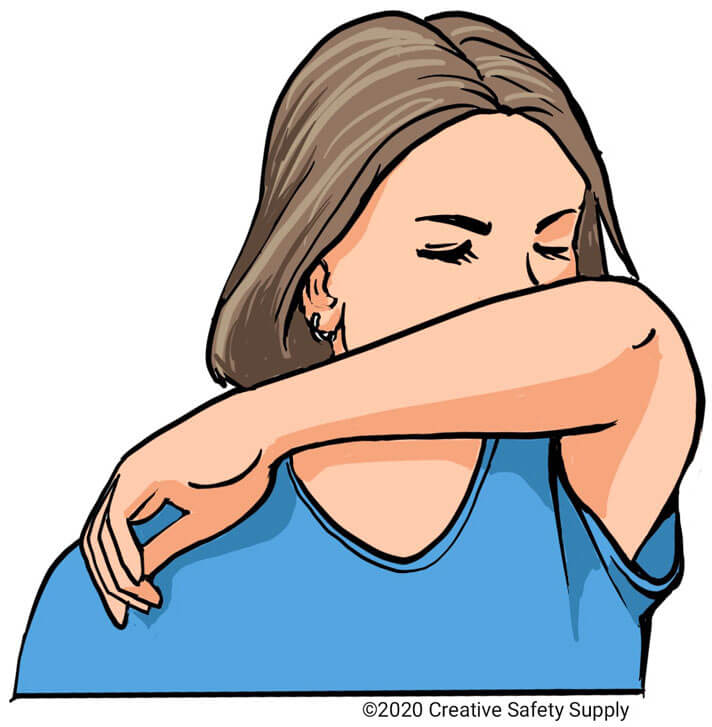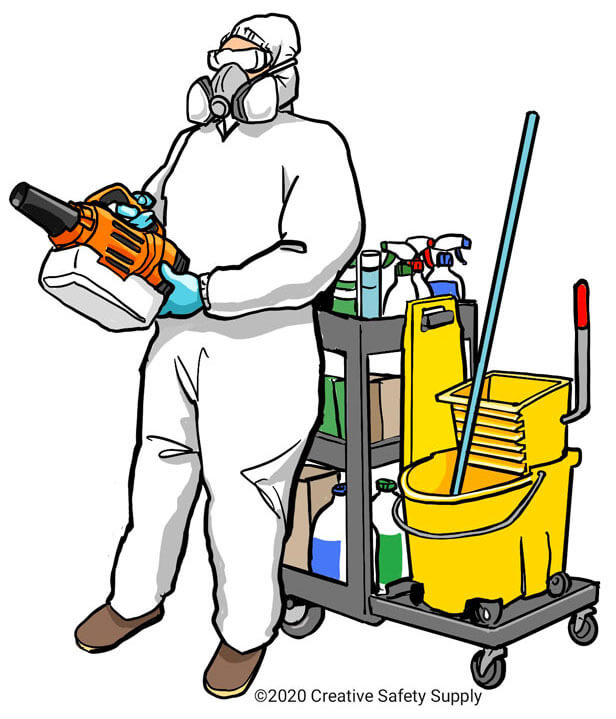
As sectors of the workforce reopen and your workers return from shutdowns due to COVID-19, there are a variety of health and safety concerns you will need to address before any employee steps foot in your workplace. The global pandemic of the coronavirus has forced businesses around the world to come to terms with a new normal—one where workers must keep their distance from each other, sanitation and cleanliness is part of daily operations, and employers might find themselves supplying PPE for the first time.
Where to begin? There are some effective health and safety practices that are provided by federal agencies that you may follow to protect your workers from contracting COVID-19 and other illnesses. For example, the Trump Administration has issued guidelines for employers who are preparing to reopen, which help you develop policies in these areas:
- Social distancing
- Personal protective equipment
- Temperature checks
- Testing for COVID-19, isolation of employees who are positive, and contact tracing
- How to disinfect high-traffic areas
- Limiting business travel
OSHA is another federal agency that has provided guidelines for addressing COVID-19 in the workplace. Its recommendations are based on guidelines that have been established by the CDC. As you develop and implement policies that adhere to guidelines from a variety of agencies, one of the most important things is to stay updated with federal, state, and local regulations that are applicable to your business, as some areas are opening up sooner than others.
Exactly what reopening looks like, and the challenges you face, will be unique to each facility. However, there are some general best practices that every employer can implement to allow their employees to safely return, and make sure everyone is on the same page.
Establish a Healthy Workplace

You likely already have health and safety protocols implemented into daily operations. Preparing to welcome employees back, however, means you must expand upon your existing protocols to further protect your employees and to ensure that you remain in compliance with guidelines. Every worker will need to take on personal and collective health practices to prevent the spread of COVID-19. The most common practices that are currently being recommended include:
- Screening workers or having them fill out a questionnaire that asks whether they are experiencing flu-like symptoms (fever, body aches, headache, difficulty breathing, cough) or if they have been in contact recently with someone who is COVID-19 positive
- Conducting temperature checks as employees and visitors enter the workplace
- Encouraging workers to refrain from coming to work if they feel sick
- Developing and implementing a response plan in case employees are confirmed to be COVID-19 positive, including quarantining and workforce contact tracing procedures
It is still important that employers adhere to EEOC guidelines and keep any health-related information strictly confidential.
Maintain a Hygienic Facility
As workers return, one of the most important practices to implement are routine worksite cleanings. You should establish a culture of good hygiene by creating new cleaning tasks that are shared among all employees. The CDC provides guidelines for cleaning and disinfecting your facility, which include:

- Reminding employees to wash their hands frequently and for at least 20 seconds
- Providing a sufficient stock of hand sanitizer, sanitizing wipes, and other cleaning supplies
- Asking employees to establish routine cleaning of shared items or spaces, such as door handles, copiers, time clocks, desk or work areas, computer keyboards, and telephones
- Encouraging respiratory etiquette (covering coughs and sneezes)
- Propping open doors so people don’t have to touch handles
- Installing plexiglass barriers where applicable
Besides individual workstations, it’s highly important to practice hygiene in lunch rooms and other break areas. It’s recommended to stop sharing microwaves and refrigerators, and to encourage employees to bring their own coffee mugs and utensils rather than sharing dishes among staff. Areas where people tend to gather and share items should receive special attention.
These changes may take a while for workers to get used to. Put up signage all around your workplace, such as hand washing signs, to communicate these newly established practices and remind your employees to practice good hygiene. Posters that describe policies and signs next to sinks can help ensure that your workers do what they can to keep the workplace clean.
Provide Personal Protective Equipment
Depending on where you live it may be required to wear face coverings while out in public. The CDC has updated its guidance on face coverings to ask everyone to wear them in order to help prevent the spread of respiratory droplets, as many people who are COVID-19 positive are asymptomatic. Many workplaces are required to ask both their employees and any customers or visitors to wear masks while they are onsite.
Besides masks, common PPE you’ll need to prevent the spread of illness includes gloves, safety glasses, and safety shields. Under OSHA’s PPE standard, employers are required to provide their employees with the necessary PPE to stay safe in the workplace, as well as training on how to safely don, doff, use, and dispose of protective equipment. Each piece of equipment should fit properly and may need routine care and cleaning.
Enforce Social Distancing
Safety in the workplace is about more than disinfecting surfaces; employers need to implement physical modifications before workers come back. The CDC has established a minimum of six feet as a safe distance in order to prevent the spread of respiratory illness, and has asked everyone to stay apart from each other as an integral aspect to social distancing. Before your employees return, ask yourself: what does social distancing look like in your workplace? As with many other safety recommendations, there are general guidelines:
- Making sure desks and other workstations are located six feet apart
- Reducing the amount of seating available in waiting areas, break rooms, and meeting rooms
- Placing social distancing strips and other types of floor marking down as a visual tool to show people where to safely stand to keep their distance
- Changing visitor policies so there are less people coming into the workplace
- Staggering or rotating shifts so there are less employees present at one time
This also may take a while for employees to get used to. Place signs all over your facility as a reminder and to thank people for practicing social distancing. You can also put signs on the doors of offices and other areas to encourage employees to comply with social distancing guidelines, and remind them about your local health authority’s restriction on the number of people allowed in groups.
Other Concerns for Health and Safety

Other workplace concerns as employees return depend on the nature of your operations. One of the biggest factors is whether you are able to allow remote work. A return could happen incrementally, as you ask certain teams to physically work in the office while others continue to work remotely. It might also be possible to ask a certain portion of your staff to come in for certain days or certain hours. Whether your job requires the physical presence of employees or not, determining which people return first should be based on your business needs.
It is especially vital to prepare for the worst: what to do if an employee tests positive for COVID-19. Before workers come back, you need to establish procedures for how you will:
- Ensure the workplace is thoroughly sanitized and cleaned (including possibly having a contract with third-party cleaning vendors)
- Conduct contact tracing to determine whether other employees came into contact with the person who was confirmed to be positive
- Possibly temporarily close your business or ask employees to return to remote work for a certain period of time
Developing these policies beforehand will help you handle positive cases in a swift manner that preserves the health of your employees and the integrity of your business.
Returning to Work
Before your employees come back onsite, you should have a plan in place that clearly explains policies and procedures and addresses a variety of topics that are specific to your workers and workplace. When you have operating practices concerning COVID-19 as part of your daily routine, then you can move on to training workers so they fully understand new policies and are able to adhere to these protocols every day. Communication is paramount to a successful transition from being temporarily offsite back into the workforce.
Be mindful of the fact that even as workers return, day-to-day activities will most likely not be the same. Although you offer the same type of work at the same location, daily tasks—and workers’ concerns—will be different. It’s important for businesses to embrace these changes. Take an assessment of your situation on a daily basis. Gauge company morale, take complaints against unsafe work practices seriously, and stay current on updates from health authorities as new recommendations are issued. Taking precautions and providing supplies will go a long way in ensuring a productive workplace and helping employees stay safe.
Similar Articles
- Cleaning the Workplace During COVID-19
- OSHA’s Guidelines to Protecting Employees from Coronavirus
- Handling Hazardous Materials Safely
- Floor Marking for Social Distancing
- Job Hazard Analysis: Addressing Coronavirus Risk in Your Workplace
- OSHA Compliance: What You Need to Know
- Staying Lean During a Pandemic
- An Introduction to Industrial Hygiene
- 5 Lean Manufacturing Tools that Work


